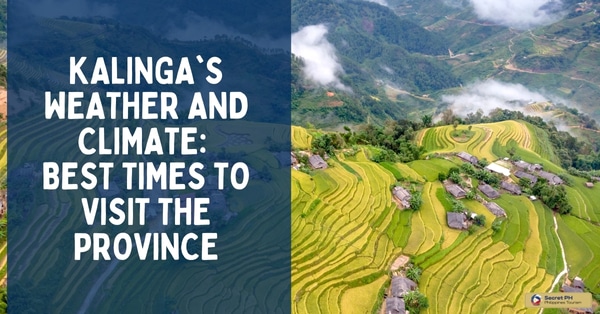Adapting to the Philippines’ weather can be challenging, but preparing for the rainy season, coping with the heat, and dealing with typhoons are important. Protecting oneself from sunburn and health risks is vital. By taking these steps, long-term visitors and ex-pats can enjoy the country safely.
Are you planning to stay in the Philippines for an extended period of time? If so, it’s important to understand how to best cope with the country’s often unpredictable climate. From the hot and humid days of summer to the monsoon season and typhoons, this guide will prepare you for all that Mother Nature has in store. Keep reading to learn how you can protect your health and stay safe while adapting to the Philippines’ weather.
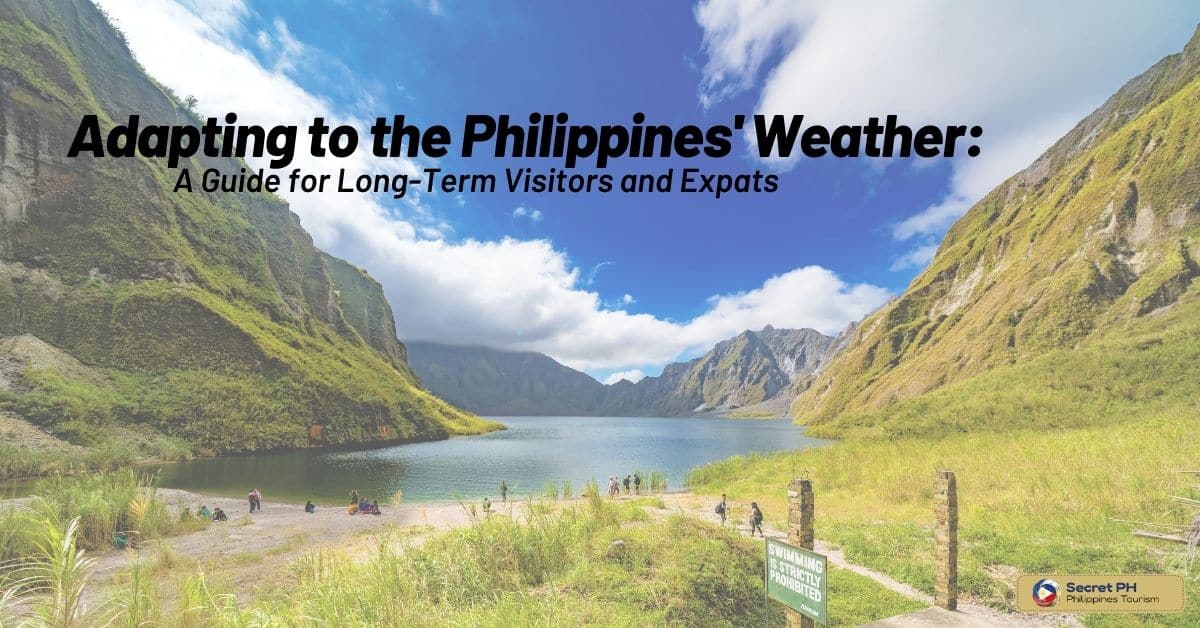
Understanding the Philippines’ Climate: Seasons, Temperature, and Humidity
Understanding the climate of the Philippines is essential for anyone planning to travel to this Southeast Asian archipelago. The country has a tropical climate, which means it is generally hot and humid throughout the year.
There Are Two Seasons in the Philippines: The Dry Season and the Rainy Season.
The dry season usually runs from November to April and is characterized by little to no rainfall and high humidity, while the rainy season, which spans from May to October, is marked by heavy rainfall and thunderstorms.
During the rainy season, the humidity tends to be lower, but temperatures remain high. The average temperature in the Philippines ranges between 25°C to 32°C, making it a destination that beckons to travelers looking for a warm and sunny tropical holiday.
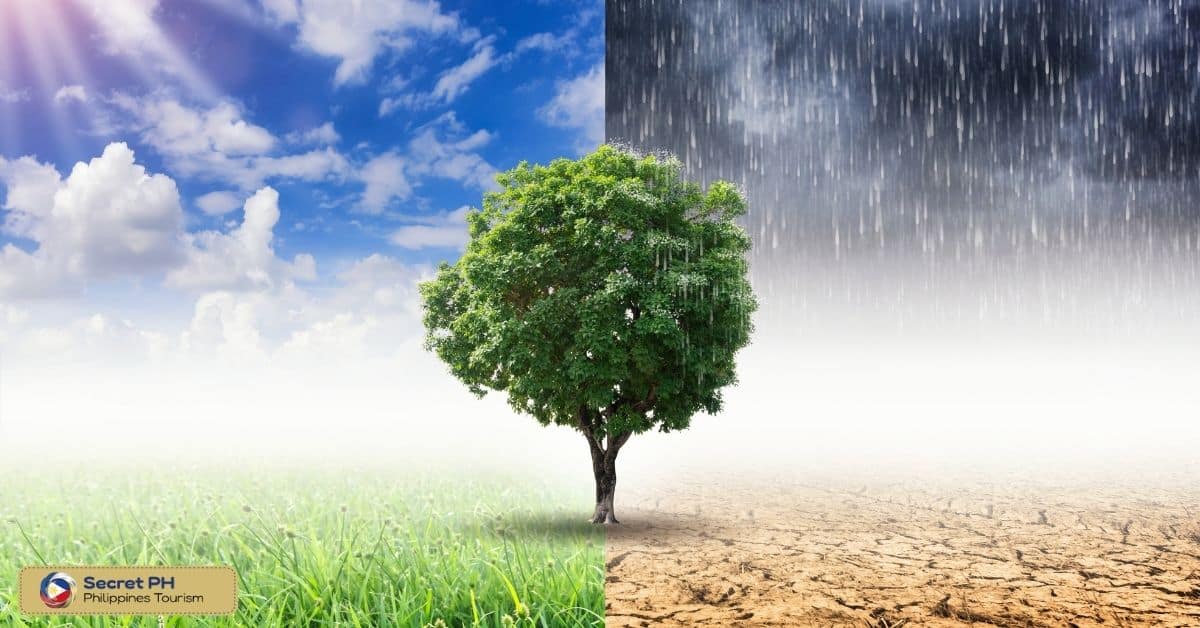
Preparing for the Rainy Season: Tips for Staying Dry and Safe
The rainy season in the Philippines typically lasts from June to November, with the heaviest rains occurring from July to September. While the rain can bring much-needed relief from the heat, it can also cause flooding, landslides, and other hazards. As a long-term visitor or ex-pat in the Philippines, it’s important to prepare for the rainy season to stay safe and comfortable. Here are some tips for preparing for the rainy season:
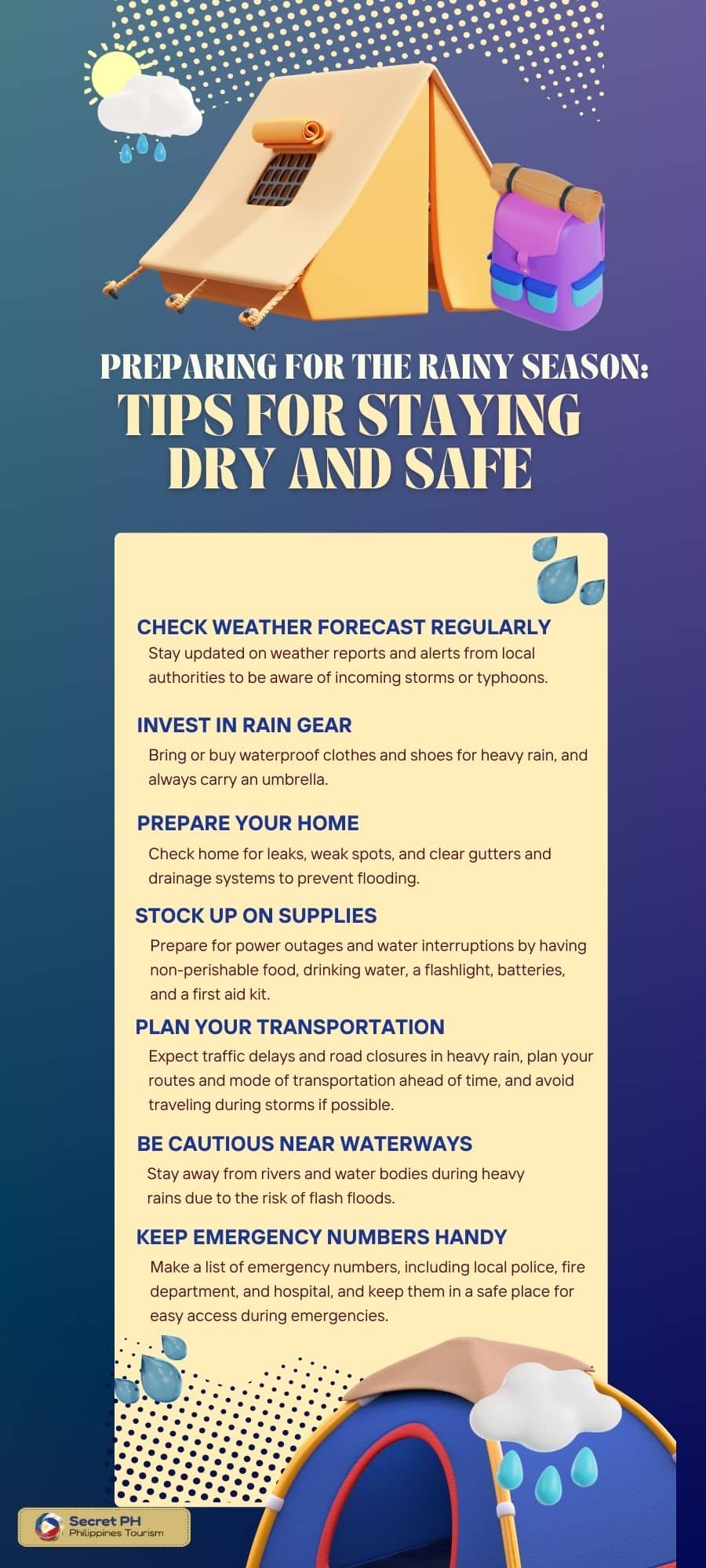
By following these tips, you can prepare yourself for the rainy season in the Philippines and stay safe and comfortable during the wet weather.
Coping with the Heat: Staying Cool and Comfortable in Hot Weather
In the Philippines, dealing with extreme heat can be a daunting task, especially during the summer months when the temperature can reach as high as 40 degrees Celsius. However, coping with the heat in a proactive manner is crucial to staying healthy and comfortable during this period.
One of the most effective ways to deal with the heat is by staying hydrated throughout the day. Drinking plenty of water and electrolyte-rich fluids can help minimize the risk of dehydration and heat exhaustion.
Other measures include wearing loose-fitting and light-colored clothing, avoiding direct sunlight during peak hours, and using a hat or umbrella to shield oneself from the sun’s rays. By taking these simple steps to combat the heat, you can stay cool, calm, and collected even when the temperatures soar.
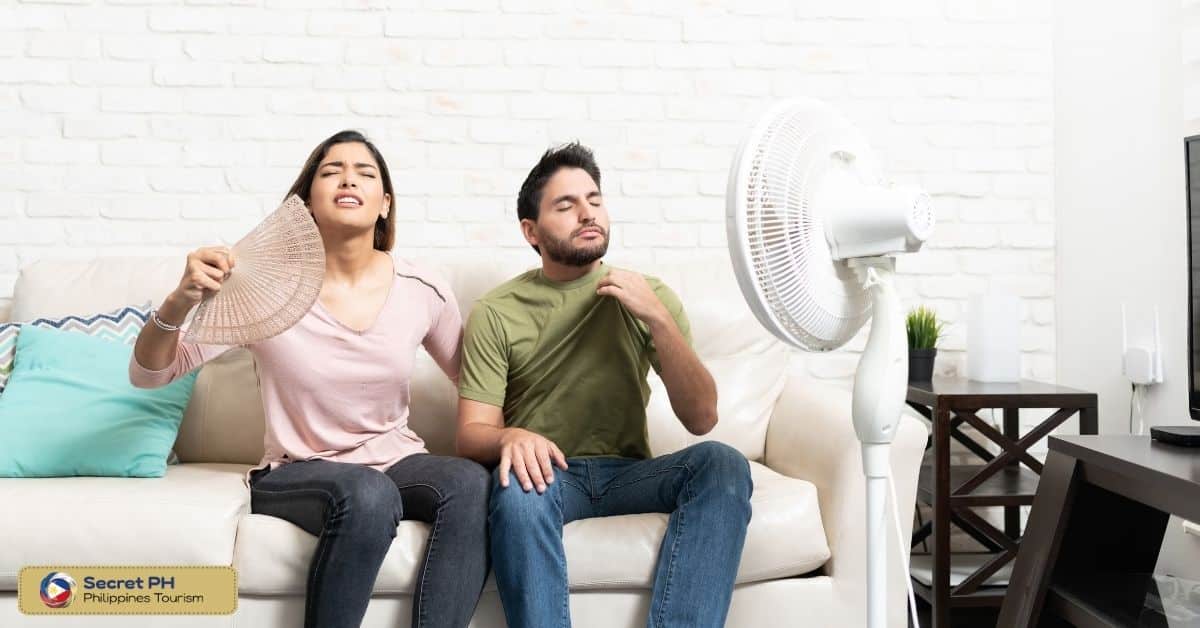
Dealing with Typhoons: Emergency Preparedness and Safety Measures
As typhoons become increasingly common occurrences, it is clear that emergency preparedness and safety measures are crucial. In order to ensure that you and your loved ones are as safe as possible during a typhoon, there are a number of things you can do.
First, it is important to stay informed about weather conditions and potential storm patterns. This will help you to make informed decisions about how to prepare and whether to evacuate.
Additionally, it is important to have an emergency kit stocked with essentials such as non-perishable food, water, flashlights, and first aid supplies.
Finally, it is crucial to have a plan in place for communication with loved ones and emergency services in case of an emergency.
By remaining vigilant and prepared, you can ensure that you are as safe as possible during a typhoon.
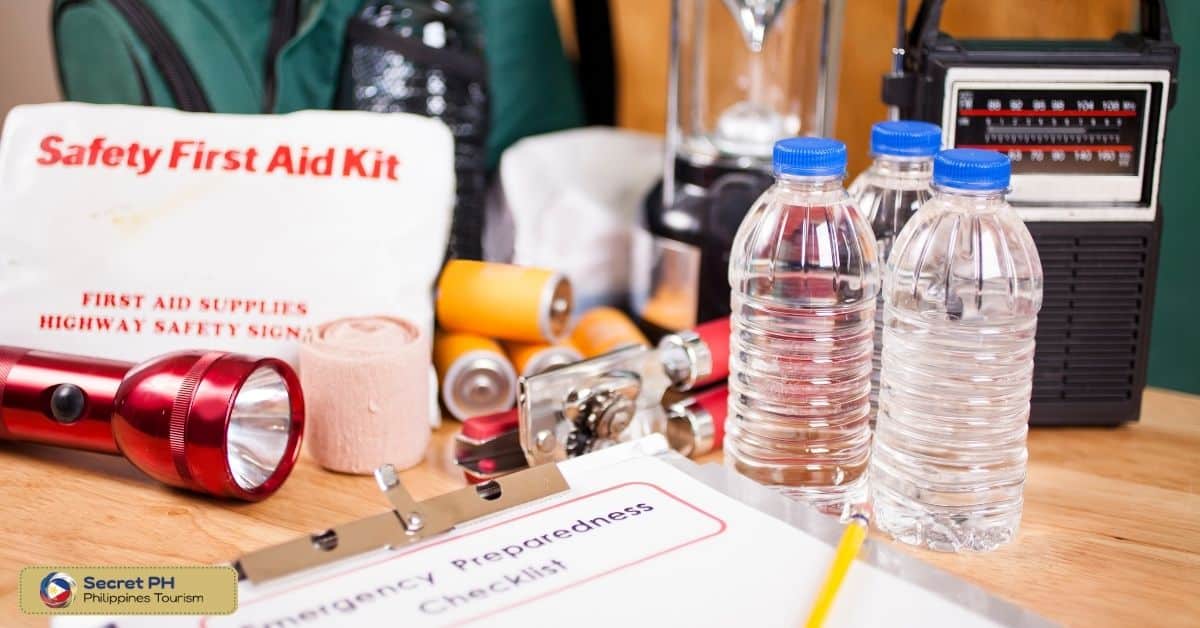
Protecting Yourself from Sunburn and Other Health Risks
The Philippines is a tropical country with a lot of sunshine, and while this can be enjoyable, it can also pose some health risks. Overexposure to sunlight can lead to sunburn, skin damage, and even skin cancer. Here are some tips for protecting yourself from sunburn and other health risks:
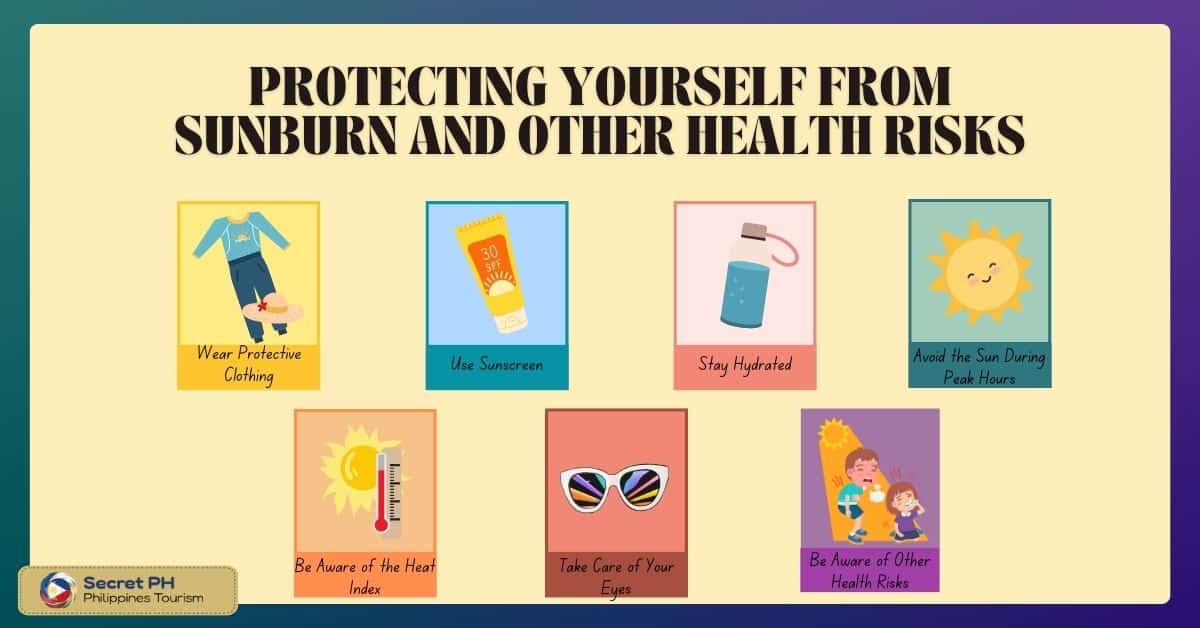
- Wear protective clothing: Wear long-sleeved shirts, pants, and hats with wide brims to protect your skin from the sun’s harmful rays.
- Use sunscreen: Apply sunscreen with a high SPF rating to exposed skin, especially if you’ll be spending time outdoors. Reapply every few hours, especially if you are swimming or sweating.
- Stay hydrated: Drink plenty of water throughout the day to prevent dehydration, which can be exacerbated by heat and sun exposure.
- Avoid the sun during peak hours: The sun’s rays are most intense between 10 am and 4 pm, so try to stay indoors or seek shade during these hours.
- Be aware of the heat index: The heat index takes into account both the temperature and humidity levels and can give you a better idea of how the weather conditions will affect you. Avoid engaging in strenuous activities during times of high heat index.
- Take care of your eyes: Wear sunglasses that block UVA and UVB rays to protect your eyes from damage.
- Be aware of other health risks: The heat and humidity in the Philippines can also increase the risk of heat exhaustion, heatstroke, and other heat-related illnesses. Be aware of the symptoms and seek medical attention if necessary.
By following these tips, you can protect yourself from sunburn and other health risks in the Philippines and enjoy the tropical weather safely.
In conclusion
Adapting to the Philippines’ weather may seem daunting at first for long-term visitors and ex-pats, but with the right knowledge and preparation, it can be manageable. From staying hydrated to dressing appropriately, these small adjustments can go a long way in making one’s stay in the country more comfortable.
Additionally, being aware of the seasonal weather patterns and planning accordingly can prevent any unexpected weather-related difficulties. With a willingness to adapt and an understanding of the local climate, long-term visitors and ex-pats can thrive in the Philippines all year round.

